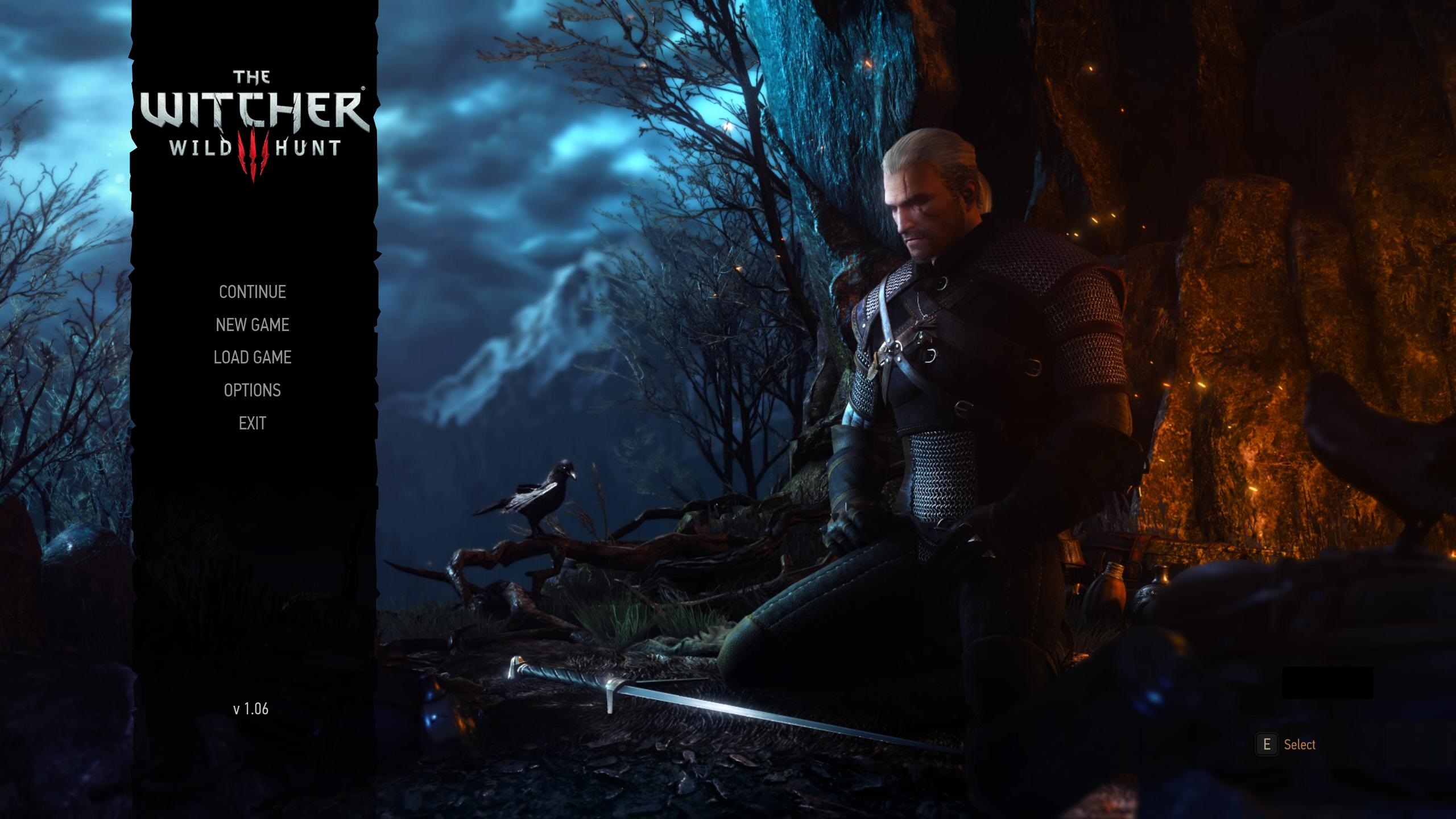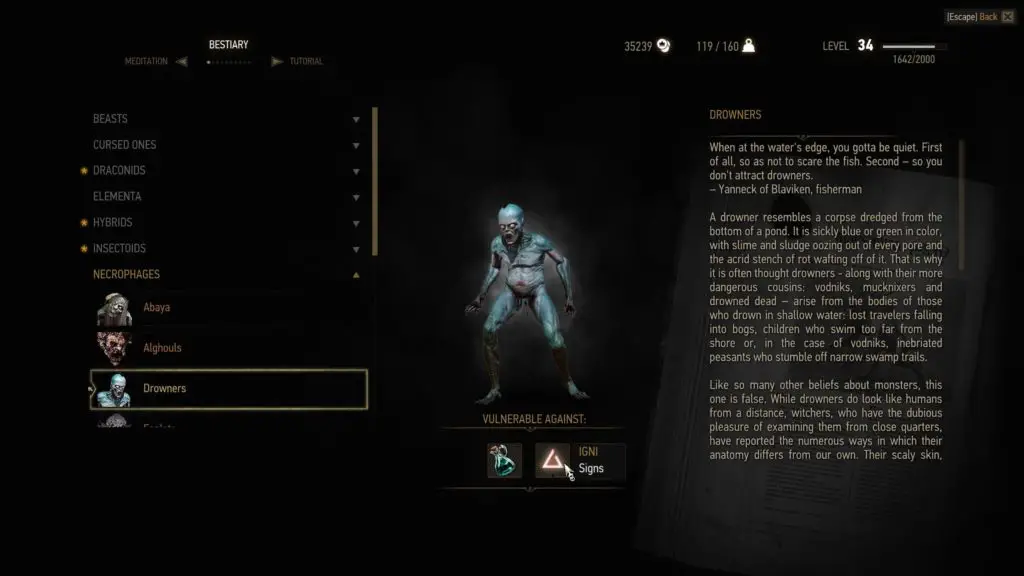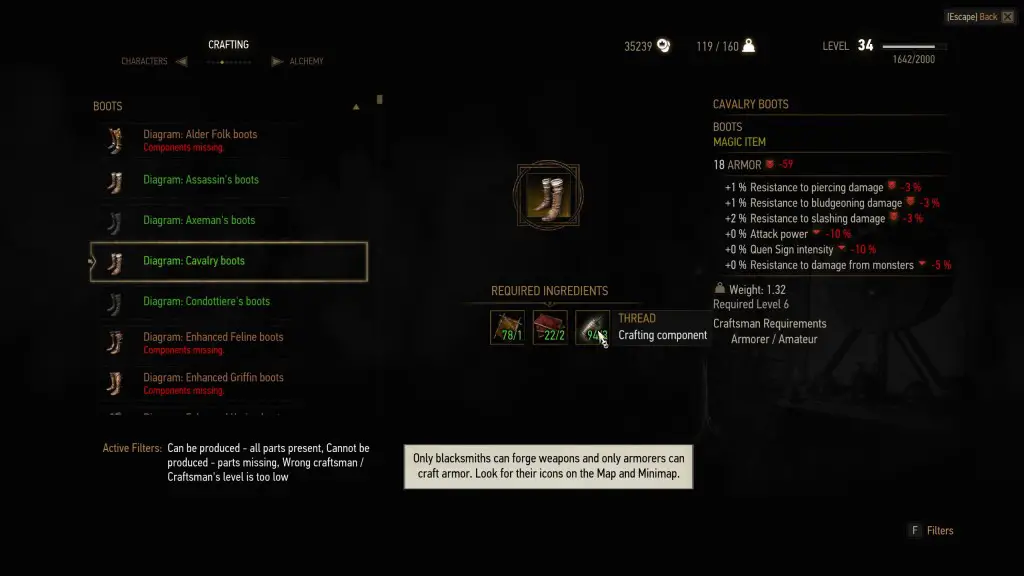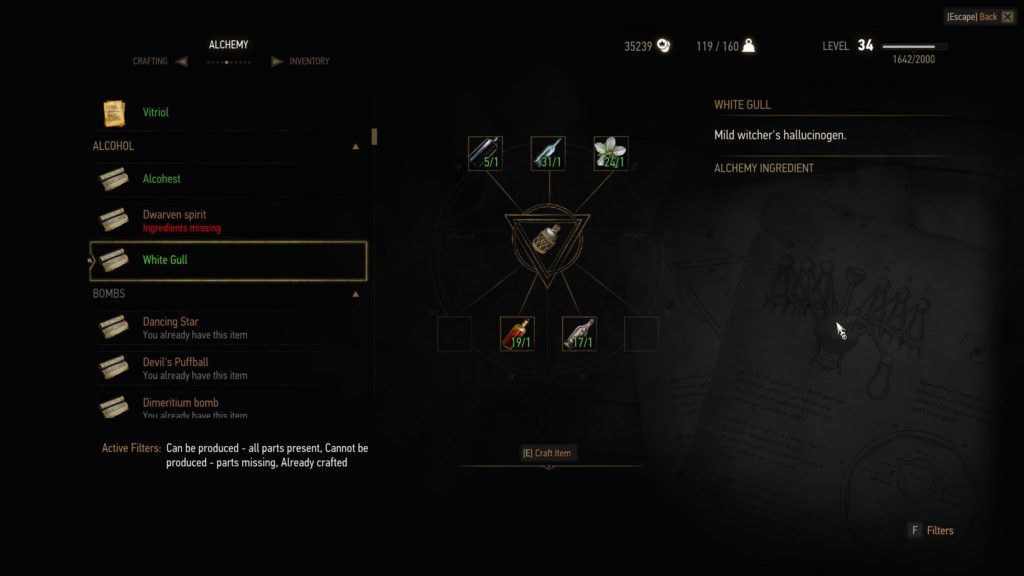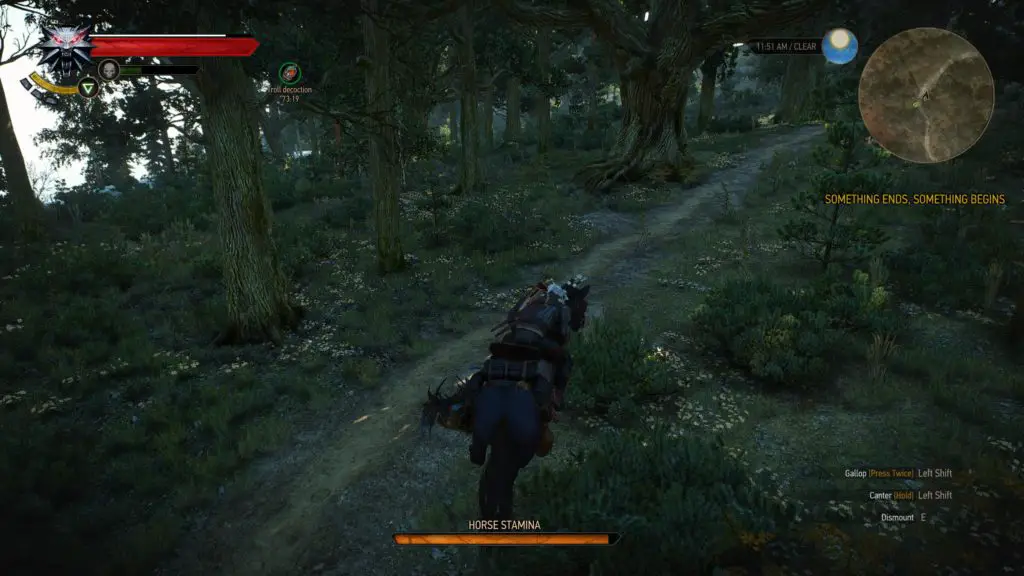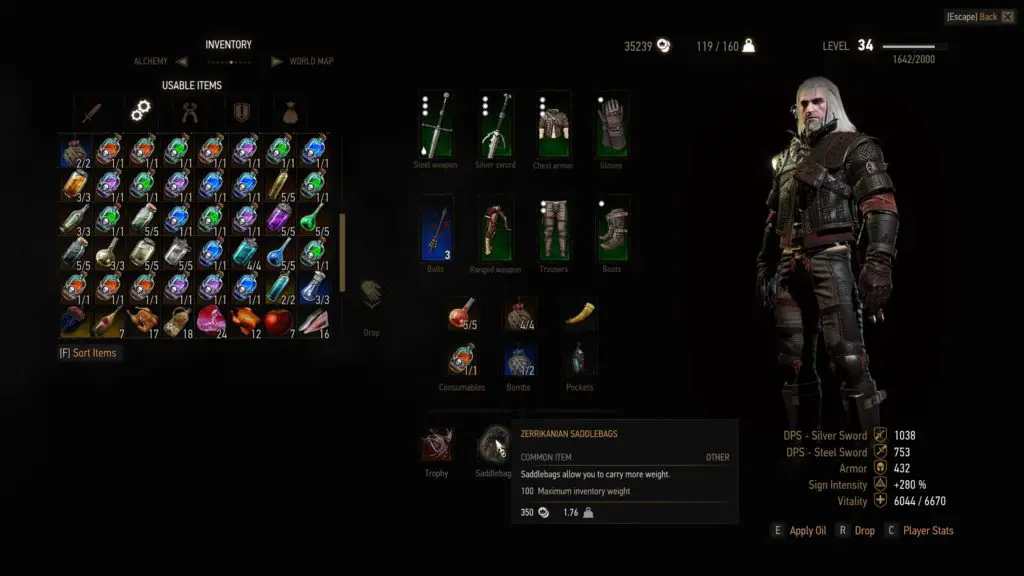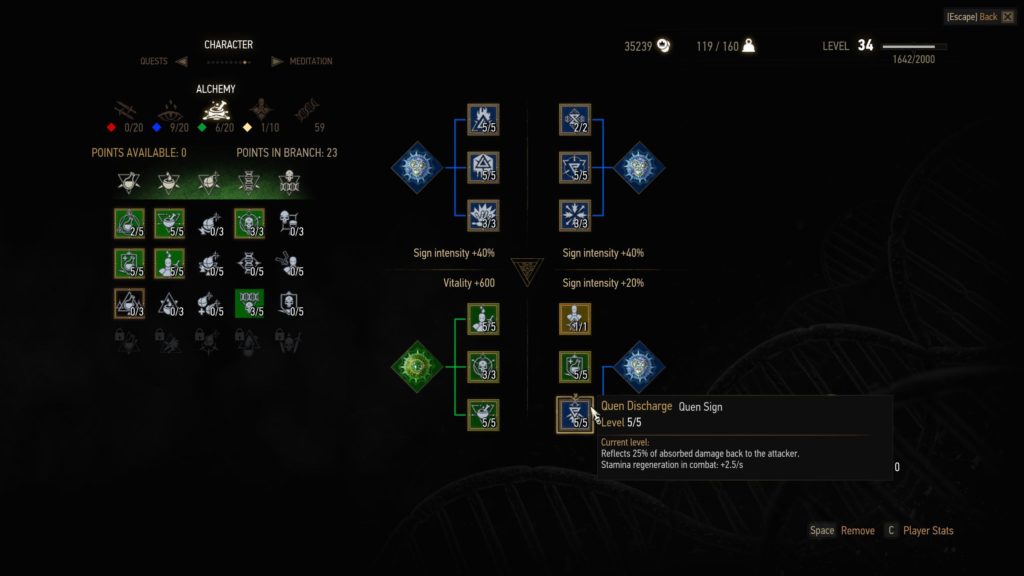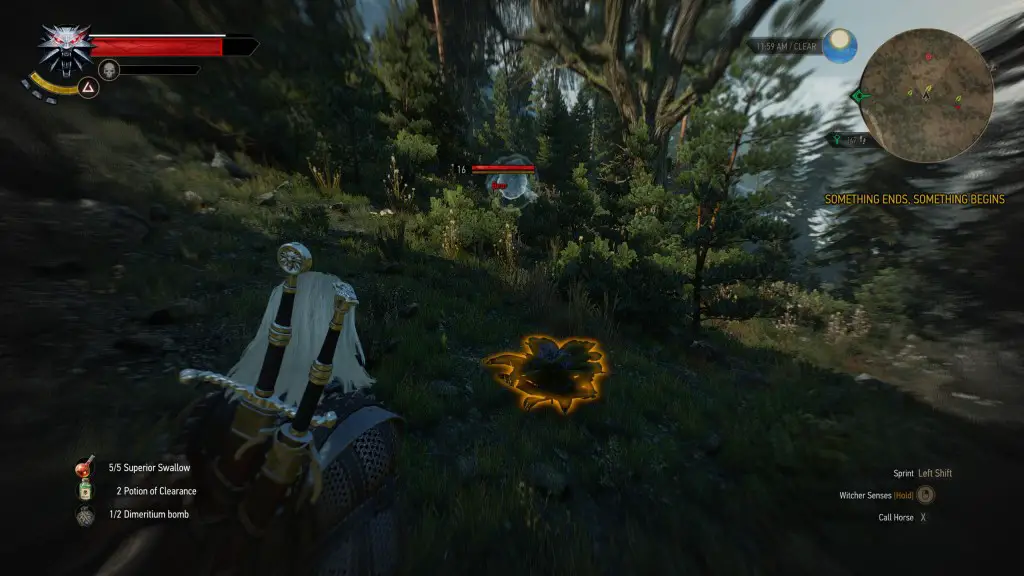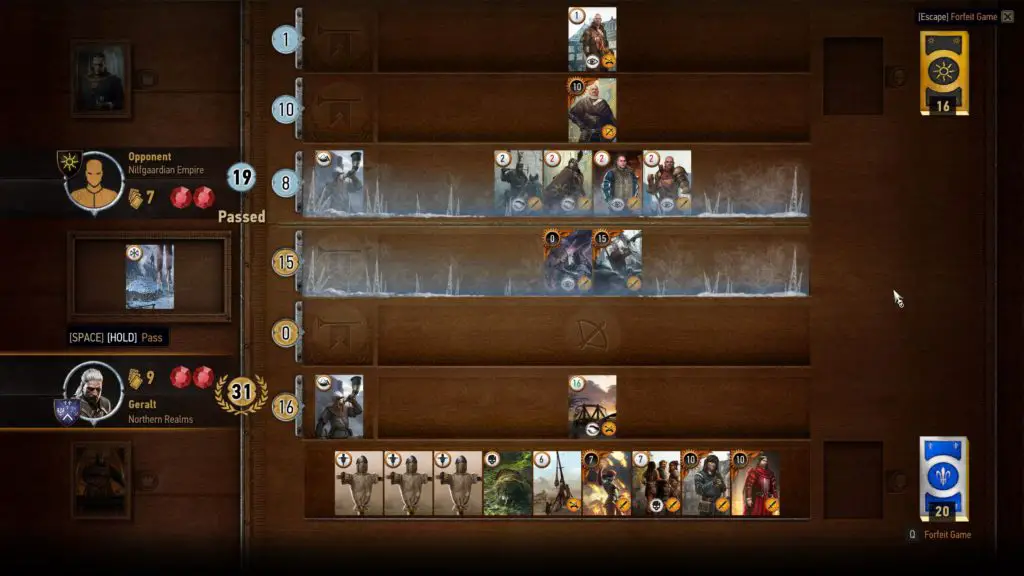The experience of being a witcher returns with Geralt using his two swords, silver and steel mixed with meteorite rocks, with an addition of a crossbow to Geralt’s arsenal. The crossbow is fairly handy in knocking flying monsters out of the sky onto the ground so they can be attacked, killing them when you’re riding in a boat, or protect yourself from monsters when you are swimming underwater searching for crafting items, or random loot. This was introduced probably to replace the hardly used thrown daggers they tried introducing in the Witcher 2 that we never used ourselves. The crossbow became a staple of weapons we used fairly often in certain fights. They made ‘choosing’ the right weapon easier compared to that from the Witcher 2. Whenever a fight starts, Geralt will grab the correct sword for the enemy type he is fighting. They probably received enough negative feedback that people did not enjoy the fact they had to choose which sword to use. To us it makes no difference, actually adds to the lore of the trained monster slayer knowing what weapon to use to dispatch a monster or a humanoid (aka man, elf, dwarf). For those who have forgotten, silver is meant for anything that is a monster, ranging from vampiric enemies, to elementals, and even necrophages (undead enemies that aren’t in the vampire family such as drowners). Steel is used on the humanoids mentioned just prior.
Another Witcher ‘tool’ makes its return without much changes done to them, of which would be bombs and oils. Oils are quite effective in helping you do more damage to a specific type that it is effective against, with additional benefits if you put skill points in it to allow it to do more damage, or better yet reduce the amount of damage you take from the enemy type it is effective against. Oils can be applied any time, even swapped in the middle of a fight if you find yourself fighting different enemy types in one engagement. Oils can only be used on the ‘correct’ weapon to use against an enemy type, helping reinforce the correct use of which sword you should be using for that fight. We used oils in nearly every fight we encountered as they are not consumed on use so once they are crafted they are always available to be applied to a weapon.
Bombs have had some slight mechanical tweaks, at the core they have remained the same. There are bombs that blind/stun an enemy, set them on fire, poison them, prevent them from using magic, and a few other variations. We found that we used bombs a fair amount, especially earlier in the game when doing damage to multiple enemies would help us control the fight a little better, prolonging our life in that fight. Later on in the game we did not use them as often, they were used when we needed them.
There are two different ways to learn ‘codex’ entries for monsters as per Witcher 2. You can stumble upon a book or you can face an enemy and learn their weaknesses that way. All this information is stored in the Beastiary where you can look this up at any time to remember what enemy is weak to what sword, signs, bombs, and/or oils.
Returning are the two different types of crafting systems as per the prior game, with tweaks performed to both of them. Crafting a weapon, piece of armor, crafting material, even runes, will usually require having the schematic, going to the vendor to see if their skill level will let them craft the item, having the materials, and the crowns (Nilfgaard gold). The added realism that not all blacksmiths or armorers are master craftsmen was a nice addition. It means that you need to explore more to find those who can craft the more advanced schematics (aka higher level gear). Enemies will sometimes drop crafting items, you can find them in random boxes, or you can disassemble items which will provide some of the crafting materials required to create an item. Disassembling also allows you to disassemble monster crafting items to get some of the base items that are used sometimes rather than their specific ‘liver’ or ‘eyes’ that a lot less schematics or recipes call for.
Unique Witcher School sets of armor and weapons have been introduced to encourage exploration of the world (usually the quest for that ‘level’ or upgrade of the set points you in the direction of the first item), not to mention that the crafted school sets are more powerful at their level than any other items that can be found or crafted for that level. There originally were only 3 school sets, with a fourth introduced not too long ago as free DLC, and as such we’ll outline all four of them. The Cat School (or feline armor) is light weight armor, focusing on mobility, promoting fast attack and stamina regeneration bonus to allow you to use signs more quickly. The Griffin School is medium armor, promoting bonuses to Sign damage and bonus protection against monster damage. If you are one who wants to do most of your damage through signs, this would be the armor set for you. The Bear School (ursine armor) is the heaviest armor, turning Geralt more into a tank with higher armor and promoting bonuses to strong rather than fast attacks. The last set, the Wolf school (wolven armor) is medium armor that is a mixture of all three of the prior armor bonuses. This is the better rounded school set, though requires higher levels to use different variations of it. It is also has the highest level requirement for the master crafted set, which is 34. Having this higher level requirement it has more armor and the swords do the most damage than other schools’ swords.
Putting a skill point into the armor type you use will further provide specific bonuses, with the Cat School skill point increasing critical damage by 25% and fast attack damage by 5% per piece of light armor worn. The Griffon School skill point increases the Sign intensity (aka damage for offensive spells, absorption for defensive spells) and stamina regeneration by 5% respectively per piece of medium armor worn. Lastly the Bear School skill point increases the maximum Vitality (or health) and strong attack damage by 5% each per piece of heavy armor worn. We originally went with the Griffin armor with the school skill point too as we know on harder difficulties using everything in a rotation will help ‘make’ the game not as hard, especially with Signs doing more damage, absorbing more damage, and having stamina regenerate quicker. Only once the Wolven armor came out did we switch to that set to give a more balanced bonuses of the three prior armor sets, with enough points into Sign skills that the loss in the loss of Sign intensity bonus from each Griffon item piece wasn’t as noticeable.
Items that Geralt can craft have been expanded upon to add more variations and levels of them. The spectre oil, that allows you to do more damage to spectres, can be upgrades twice provided you find the recipes which increase their effectiveness against spectres. This is another great way to promote exploring an entire cave, ruin, bandit camp, in order to find these recipes. Unfortunately we did not find every single oil upgrade, though we probably missed a few from the case of having full inventories and sometimes skipping a box that may have had it. Bombs and potions have the same sort of three tier leveling, though we were able to upgrade more of them. Certain superior potions would have bonuses such as lasting the entire night rather than its limited duration listed. A change was made to the ‘maximum’ amount of bombs and potions that you can carry at once, with higher levels of the recipes allowing you to carry more. An interesting twist is that once you have crafted the item once you never have to craft it from the crafting materials. Instead you have to have a certain alcohol base that is consumed every time you rest and have a deficiency (aka used one potion, or one bomb). We enjoyed this as it meant we only have to craft the item once, and just have to keep buying the ‘refill’ base that would re-craft all the potions and bombs we had back to their maximum number that could be made. With the limited quantities and only able to refill them while resting (aka out of combat) you can use potions whenever you want, which makes it a lot more enjoyable as sometimes combat will come out of nowhere, or you’ll need something for one enemy, but the next enemy that shows up requires that slight different potion or bomb tactic.
Decoctions are something else that has been introduced into the game. They usually require more rare ingredients, such as a mutagen or specific item from a monster that a fair amount of the time isn’t found from an enemy unless from a witcher contract. They also happen to last much longer than a potion does. A potion usually lasts a few minutes at most (skill points into alchemy can increase how long the potions last). The Troll decoction can only be crafted after getting a liver crafting material from killing a troll, though it is well worth it as it increases the regeneration of vitality both in and outside of combat. It may not regenerate health as quickly as say Swallow does, but it will last much longer and the two can be used at the same time to boost your health back in times of great need. There are quite a few different variations and types of decoctions which will more than likely fit your specific play style. Unlike potions, decoctions can only be used once before you have to rest and reuse them (unless you use the decoction that allows you to re-use all used decoctions), which is why their duration is much longer than potions.
Toxicity will limit the amount of decoctions, potions, or combination of the two so that you cannot just overpower yourself with four different decoctions and five different potions. Hitting the maximum toxicity will cause Geralt to lose health until the toxicity has lowered enough, Geralt dies (and thus restarts) or a White Honey potion is used, which clears both toxicity and bonuses from the potions. If you were like us, we put some points into Alchemy to increase the potions duration so that we had them lasting about an hour. We also put some skill points into increasing the maximum toxicity by the number of alchemy formula known. This allowed us to usually be able to use two decoctions and about two potions in a fight before having to worry about nearing the 90% toxicity limit where Geralt starts to lose health.
The use of oils, bombs, potions and decoctions are rather important on the harder difficulties, especially Death March (hardest difficulty) as sometimes it can be the difference between beating a boss or a horde of enemies and having to start over to do it again and again. We should briefly note food and drinks have returned, yielding a short health generation though usually you need to chain it several times to really generate a lot of lost health.
Now onto the scourge of having enough inventory space as it plagues gamers in games that limit how much you can carry at one time. Gone are the storage chests that will let you store and access items whenever you want, easing your inventory weight limit. Instead you can increase the amount of weight that your horse can carry, thus expanding your inventory weight limit. This does make more sense than randomly located chests as your horse, Roach, is a method of transportation that you can call and is seen with a saddle bag, thus carrying your items. The saddle bags can be upgraded either from buying a better one from specific vendors or competing in various horse races which will let you win them without spending any money. The game does not ‘destroy’ items you’ve dropped or left on the ground, so if you do run into the fact you horde crafting materials (like us), you can always drop them by your favourite NPC vendor without fear of it disappearing after you go to another zone or load your game back up the next day. This is a nice feature we didn’t really use much ourselves, but know people who used it to their advantage. We will admit we horded a lot more crafting materials in our inventory then we really needed to since we did not want to have to decide a specific spot where our ‘stash’ would be, who knew when you might need material x or y at a specific craftsman halfway across the world. The logical place would have been at the Novigrad dwarf banker who can exchange different currencies for you. Maybe we’ll do that next play through?
The inventory system is not organized as tightly as the second game, which we wish it had been. It would have been nice to have tabs for all our potions/decotion/oils, then another for food. Plants and other crafting materials could have been once again separated. They may have slightly simplified this to make it easier for console gamers to navigate their menu, as there is an ‘automatic’ organizer button that will organize items in certain groupings, but we would of liked to see if it could have been alphabetical for at least the potions/oils/bombs as sometimes they would move somewhere and we would have to spend a few minutes looking for it. First world problems eh? We would not be surprised if someone has made a mod out there that solves that problem for us.
The Witcher 3 has decided to freshen up their Skill Trees as it is no longer appears like a tree, but more a collection of skills that can be unlocked and ‘enabled’. That means for three of the four trees, you need to put X amount of skill points into any of the skills before you can unlock the next row/tier in that ‘tree’. Even if you have unlocked the skill unless you drag it over to the right (into one of four grouped skill slots) then it will just be unlocked but active or in use. Skill slots are periodically unlocked based on what level you are, limiting you to ultimately 12 different skills you can have ‘active’ at one time. There are also 4 different mutagen slots which are tied to each group of three skill slots. Putting say a green mutagen (which gives a boost to vitality) in the same group of three skill slots that has a green/alchemy skill in it, it will increase the bonus of that specific mutagen by 10%, to a maximum of 30%. IF you end up not liking a specific build or want to try something different, you can buy a potion that will reset your skill points from several vendors across the world, costing only 1 000 crowns. That may sound like a lot earlier in the game, nearing the end we had over 45 000 crowns. It’s hardly a dent in the gold purse to respect. Please refer to the next screenshot as it will expand upon what we were describing for the enabled skills ‘tree’.
Now that we’ve explained that we’ll get into the four different Skill Trees. The Combat Tree (which skills are red and boost red mutagens) is broken down into five sub-categories containing; Fast Attack, Strong Attack, Defense, Marksmanship, and Battle Trance. Fast Attack, Strong Attack and Marksmanship all increase the damage done by the specific attacks with a sword (first two) or the crossbow (the last mentioned). Furthermore, it can unlock a special move for Fast or Strong attack which usually consumes either stamina, adrenaline, or both. Defense and Battle Trance are more generalized bonuses, such as Defense will let you parry arrows fired at you rather than having to dodge or roll out of the way. Putting a point into any ability in this tree increases the adrenaline generation by a certain amount, with it only being active if that ability is enabled.
The second tree revolves around Signs (that are blue and boost blue mutagens) and are also broken into five sub-categories, each one involving one of the five different signs; Aard, Igni, Yrden, Quen, and Axii. Putting points into one will increase damage, duration, absorption, and even unlocking alternative modes. An alternative mode of Yrden is a little turret that when cast on the ground will attack enemies who are close to it, slow them (like Yrden does in Witcher 3) and shoot arrows out of the sky for you. Boosting the first level of Axii will allow you to use it in certain conversations against NPCs to attempt to choose an outcome of a conversation. We put quite a few skill points into it for the Axii bonus, as well as allowing Quen to absorb more damage, reflect some of it back, and make Igni a very powerful skill that can burn down some of the enemy’s armor, allowing us to do more damage to it. For Signs, any sign point enabled will increase how fast stamina regenerates, increasing the frequency that you can use a sign.
Alchemy tree comes in as the third tree (which we mentioned are green and boost green mutagens) with the sub-categories of Brewing, Oil Preparation, Bomb Creation, Mutation, and Trial of the Grasses. Some benefits of this tree are increasing the duration of potions, decreasing the damage done by an enemy who is vulnerable to the oil being used on a sword, increasing maximum quantity for bombs, and increase the mutagen bonus. IF you are one to use a lot of potions, bombs, and/or oils, this is the tree for you as every point put into this tree (and the ability enabled) increases the duration of potions consumed. This is how our decoctions last about an hour for us.
The last tree covers General abilities, they can be used in any combination and are not tied or related to any of the other trees or mutagens. The main one we used is the one mentioned earlier that related to the School ability (based on what weighted armor you wear, get certain bonuses). The type to use a lot of potions, then picking up Metabolism Control will increase maximum toxicity by 30 allowing you to use more of them at one time. Rage Management was useful earlier in the game as it let us use adrenaline points to cast a sign if we were waiting for stamina to regenerate, however, this ability really shines if used with Focus, which increases the amount of adrenaline generated by weapon damage and signs (or if you put go heavily into the Combat Tree for the adrenaline generation boosts).
Witcher Sense has been improved upon from the Witcher 2, allowing us to ‘see’ things that normal people would not be able to. It is an intriguing view as it gives us a look into what else a witcher can sense. Such as their enhanced sense of smell allowing them to pick up on a strong perfume and track it. Spotting cracks in a weak wall, detecting the air rushing through it. Hearing enemies in the distance. Mind you Witcher Sense can only be used while not in combat, it has no advantage or use in combat either. It is namely used like a ‘detective’ tool a lot of the time to track down a target, be a monster, man or beast. We used it a lot when searching to see what could be looted, and is needed for most treasure hunts too, who hides the chest in the middle of the woods?
It isn’t a Witcher game without having ‘mini-games’ in it, with some changes to them to keep it ‘fresh’. There are side quests for most of them as per the Witcher 2, with one of them being so generalized that unless you explore everywhere, shop at every vendor, and beat every opponent it is impossible to complete. More on that shortly.
Dice Poker, one of our favourite games has been completely removed from the game. This was a little odd to see as it was a staple for the prior two games, even mentioned at times in the novels too. Instead we’ll say the game of chance was replaced by the game of chance AND skill. Gwent.
Gwent is a card game that is ‘similar’ to Magic the Gathering where you build a deck of cards based on four different factions, then battle an opponent with those decks, using only the cards you’ve drawn to defeat your opponent. Thought we would leave it at just that, well you don’t know us well enough. Gwent is much more involved than other card games such as Hearthstone which is more RNG (Random Number Generator) then it has to do with skill. In Hearthstone you can build an amazing deck, but unless you can get certain cards in certain orders (or have every card unlocked/bought) you can lose time and time again. Gwent solves that problem in making the deck building a key part, but not limiting it to as much of RNG. Having a good deck involves planning out what strategy you want and sticking to it. We’ve had matches where RNG has given us a fairly ‘bad’ deck but we were able to leverage it against the NPC’s deck and still win.
The game is played by each player drawing 10 cards, playing one at a time, going back and forth until someone wins. Once you ‘pass’ in a round, you can no longer play any more cards for that round. In order to win, your army must have more ‘damage’ on the battlefield then your opponent. It is a best of three rounds, where you cannot draw any more than the original 10 cards you drew unless you have special cards that let you draw more from your deck. Most cards will have a number on them, indicating the amount of damage they do and what of the three rows of combat they fit in. Those rows are Melee, Range, and Siege. You can only place a melee card in the melee row, with certain cards that may be played that will boost the damage for all units on a specific row (such as melee). You can also play a Specialty Card, such as Frost, that will reduce all non-hero melee cards on the battlefield to base attack of 1. This means if your enemy has a lot of melee cards for one round and plays them, playing a Frost card from your hand you can lower that army’s damage significantly, allowing you to potentially win. Specialty cards have a limit of 10 of them in your deck. Aside from that there is no limit to the amount of cards you can have in your deck. There is no limit on the number of hero cards you can have in your deck.
The only cards that are not affected by Specialty Cards are Hero Cards. They will do whatever damage that is listed on them (their damage will never increase or decrease), the drawback is they cannot be revived from the graveyard after that round is over, so use them strategically. There certain unit cards that allow you to revive other unit cards from your graveyard. There are certain cards that will let you draw more cards from your deck, Spies, but when they enter the battlefield they go to your opponent’s side giving their army a boost. Using this along with an environmental card you can help negate that fact, or ‘play’ the first round to drain as many cards as your enemy has then mop up in the second and third rounds. You can change your deck any time you want when not playing an opponent, allowing you to try different strategies when you buy or win new cards. This honestly is one of our favourite ‘mini-games’ of all time and hope that CDPR will release a standalone version as we would look forward to playing against real people on your mobile devices or just across the internet on the platform your game is installed on. They would of course need to change some deck building mechanics to limit say number of heroes to make it a more balanced competition. We could go on more about the game explaining even more but we really shouldn’t be wasting all your time here on that.
Fist Fighting has returned and undergone a re-imagining. Rather than it just being quick time events…which we slightly miss (just for the fist fights), it went back to its roots similar to that of Witcher 1, where you have to be involved. You have the ability to do fast attacks, strong attacks, counter, or dodge. On Death March you need to get used to dodging or countering an enemy in order to not see a quarter of your health go down each hit (we’re exaggerating for some of them). We found that either perfectly timing counter, which blocks the enemy attack then disorients them to allow you to attack them or just dodging out of the attack then one or two quick attacks was the best course since it seems how the game was setup. It was frustrating at times against specific enemies in specific ‘arenas’ namely due to them being very close quarter, with time we were able to defeat every opponent. The ones that REALLY annoyed us were when you had to fist fight two opponents. Timing to dodge, counter or attack to only have to deal with one at one time was rather challenging with one of the two fights where you fight two we couldn’t beat them, and just gave up (if you lose you have to pay potential bouncers you’re hiring). What we would have liked for Death March was if those enemies did less damage than a normal one fight fighter to balance it out, nope instead we had to dance a lot with dodge and try to bait one to be closer than the other. The one two man fist fight we did win was very intense that made us quite proud of ourselves when we beat them and didn’t have to do it again. What doesn’t make sense is one of those fist fights you can’t use your weapons, even though it involves criminals.
Arm wrestling has disappeared, replaced with something completely different, promoting the usage of the new traveling companion. If you couldn’t guess what we were getting it, it’s horse racing. Horse racing is a great way to make some crowns and get free upgrades for Roach, blinders allowing him to be scared less by enemies, saddles which enable him to run longer by boosting his stamina, or saddle bags which increases the maximum amount of weight that can be carried (inventory space). The races themselves can be found throughout the game, similar to Gwent they have a few occasions where they are part of the main storyline, so doing all of them to get the upgrades (namely the saddle) to make the races ‘easier’ and get some practice. Due to the courses that you run for a horse race, it is able to block an opposing riding from passing you by using select locations to ‘block’ them while Roach’s stamina refills. Now we’re not sure if this was intended or not, but we do know that this would seem like viable tactic in real horse races (not at the track). As a whole we quite enjoyed the horse races, wishing there had been more really.
Roach, your horse, is one of several ways to get around the world within the Witcher 3. You are able to call for him as long as you are not in combat or inside, where you can have him walk, trot (uses no stamina), or run (uses stamina). It is the main way to travel that is faster than running when you have not visited an area and have not discovered its sign post. Sign posts, once discovered in a town, city, or sometimes ‘named’ place, allows you to fast travel to any sign post, provided you are already at one. Some people have complained you should be able to use the fast travel system whenever you want, we disagree, enjoying the fact that you can’t exploit the fast travel system after having gone off in the middle of nowhere, plan ahead. Another way to get around is by boat. Boats unlike Roach, are not indestructible. It is possible to run them aground, sink them by running them into too many objects, or by having enemies (namely harpies) attack parts of the boat and destroy them over time. You can also fast travel on boats, provided you are in one, and moving, you can pull up the world map, select a port of a place you’ve visited before and bam you’re at that port.
